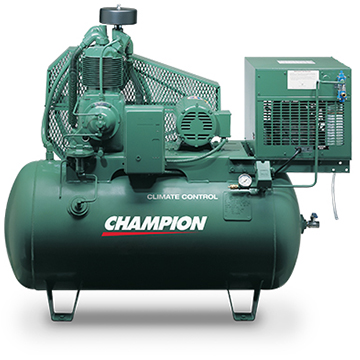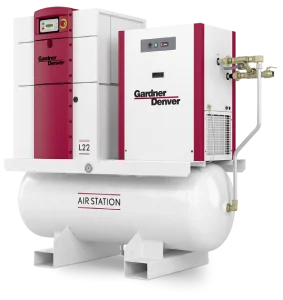
 Some Things to Consider...
Some Things to Consider...Many customers because of a lack of plant floor space or due to safety (noise / heat related) requirements install their compressed air stations outdoors.
If this is you? It is highly recommended you use some type of weather protection to keep blowing rain, snow, ice or dust from entering your air compressor intake. NEMA 4 controls and TEFC motors and sound enclosures can be supplied by the manufacturer but some type of protection such as a lean-too cover or awning is always recommended.
Several customers in my area use a metal canopy or a pitched roof cover on concrete slab next to an exterior building wall and have either fence wall around the area or some will use tarp walls, put up primarily in wintertime, to trap heat from the compressor.
For cold weather operation, I have pasted below an excerpt taken from one of the GARDNER DENVER service manuals:
Figure 2-3 – COLD WEATHER INSTALLATION INSTALLATION FOR COLD WEATHER OPERATION (Figure 2-3) - It is recommended that the unit be installed inside a shelter that will be heated to temperatures above freezing (32 F, 0 C). This will eliminate many of the problems associated with operating units in cold climates where freezing rain, drifting snow, freezing condensate and bitter cold temperatures are encountered.
Refer to Gardner Denver Engineering Data Sheet 13-9-411 for the advantages of using AOL desktop gold customer service the heat recovered from your rotary compressors. This heat recovery could easily pay for an adequate shelter for the unit.
When an outside installation must be made, the precautions required will depend on the severity of the environment. The following are general guidelines for outside installations:
Cold Weather (Down To +10 F, -12 C)
1. Be sure all drains, traps, and control lines, including pressure transducer lines are heated to avoid freezing of condensate. Heat tape with thermostat control is generally satisfactory for this purpose and can be obtained at various local plumbing or hardware outlets at nominal cost.
2. If an air-cooled aftercooler is to be used, provisions to bypass the aftercooler must be made. Since cold air contains very little moisture, successful operation can be achieved without the aftercooler.
3. Provide at least some simple shelter such as a plywood windbreak to protect against drifting snow.
4. Use only Gardner Denver AEON 9000 SP lubricant.
5. Monitor the unit carefully during start-up and operation to be sure it is functioning normally.
6. Specify NEMA 4 enclosure for electrical devices.
Another item to consider when mounting your compressed air station outdoors is your Compressed Air Receivers. If your air receivers are mounted ahead of your system dryers, bulk condensate will collect in bottom of tank and typically an automatic electronic or float drain is needed. Many companies do not run compressors on the weekend and this fluid that is collected in the bottom of tank and possibly in the air lines feeding the tank will freeze during winter conditions.
To protect yourself from future headaches it is recommended to insulate your outside pipe and also the condensate drain used on tank. There are condensate drains available with internal heaters that will also solve this problem.
As far as air filters and air dryers (refrigerated and desiccant) mounted outdoors – please see below excerpt taken from cagi.org (COMPRESSED AIR & GAS INSTITUTE) website regarding the myth of air dryers installed outdoors.
Myth: Any dryer (refrigerated or desiccant) can be installed outdoors.
Fact: All standard dryers are designed for internal installation. However, many are often installed outside, (with a lean-to roof in some cases and without a lean-to roof in some cases). Outside installation is acceptable provided there is lean-to roof with freeze / snow protection, blowing rain protection, and a roof / ceiling high enough to avoid hot air re-circulation. Outside installation of standard dryers with no roof is not recommended.
Low ambient protection such as heat tracing drains and interconnecting piping can be supplied at the time of purchase to solve this problem.
Another problem some of my customers with regenerative dryers encounter is that when the dryers are mounted in a secondary building with outside piping between buildings they have seen poor dew points or shorter desiccant life. Condensation may be formed from outside non-insulated piping or pipe drops and the downstream desiccant dryers see excessive amounts of inlet condensate that will not allow the desiccant to work properly or corrode the desiccant from excessive water.
To potentially protect yourself from this problem, it is HIGHLY recommended to have a secondary air receiver ahead of the dryer that will catch bulk water or condensate and reduce or eliminate the moisture collected on outside piping exposed to varying wintertime and summertime conditions.
It is also true that a secondary air receiver should be included for refrigerated air dryer installations for outside piping for the same downstream moisture problem.
Air receivers are a low cost item compared to downstream instrumentation or precision valves used. In fact, a small air receiver can be as low as $ 200.00.


